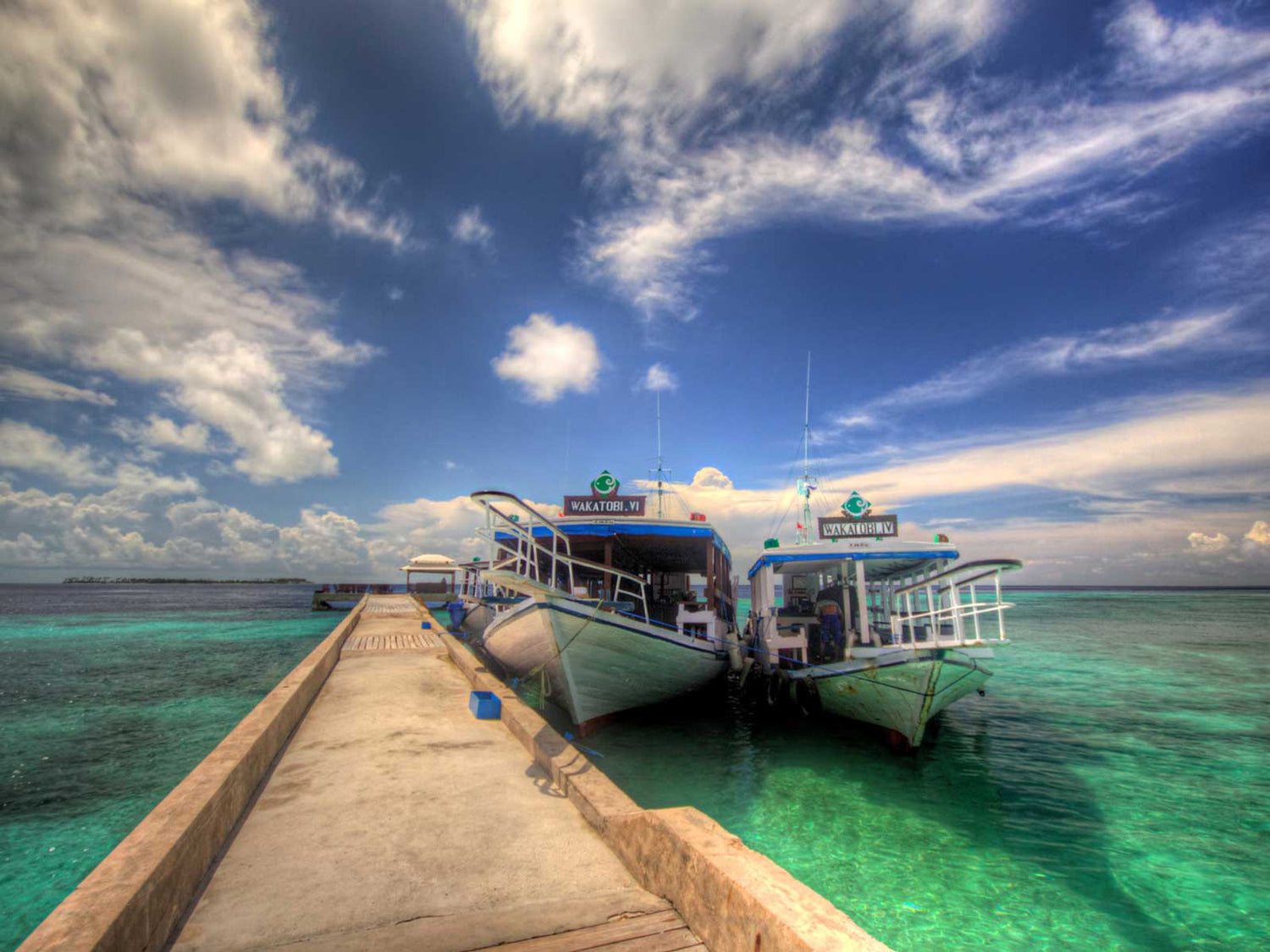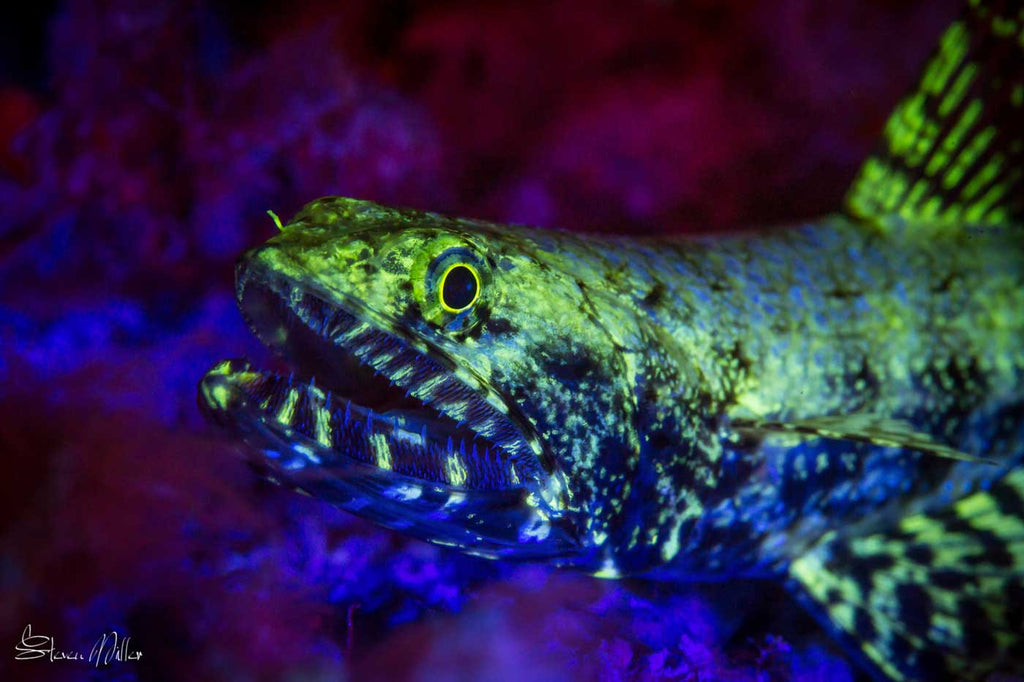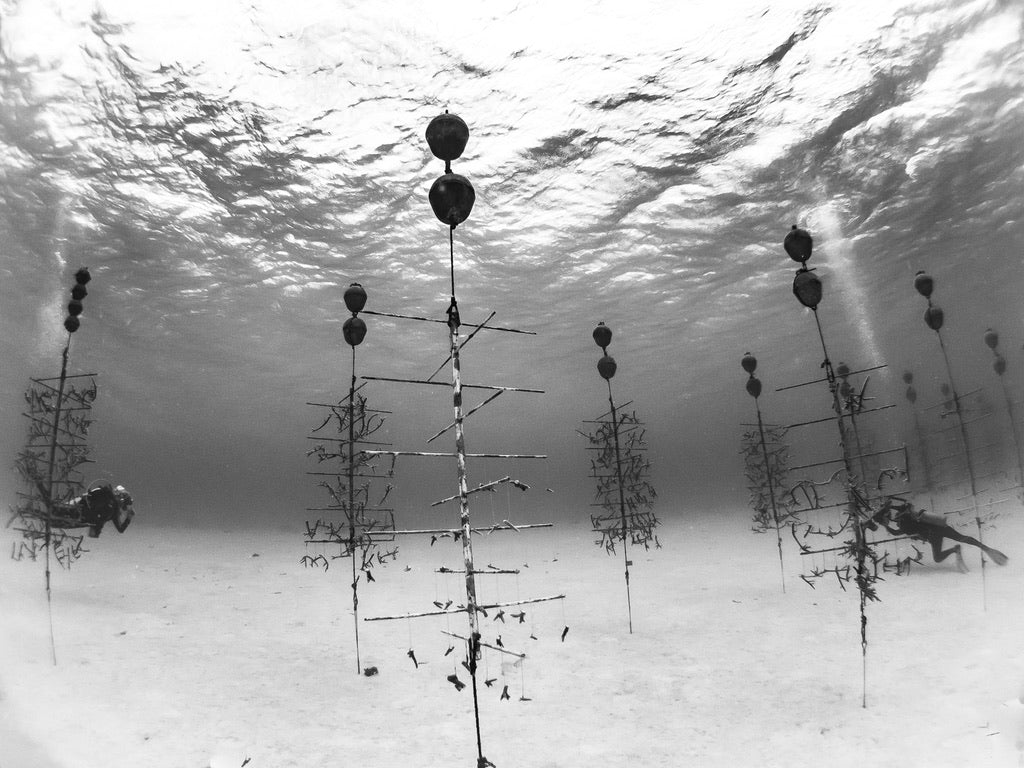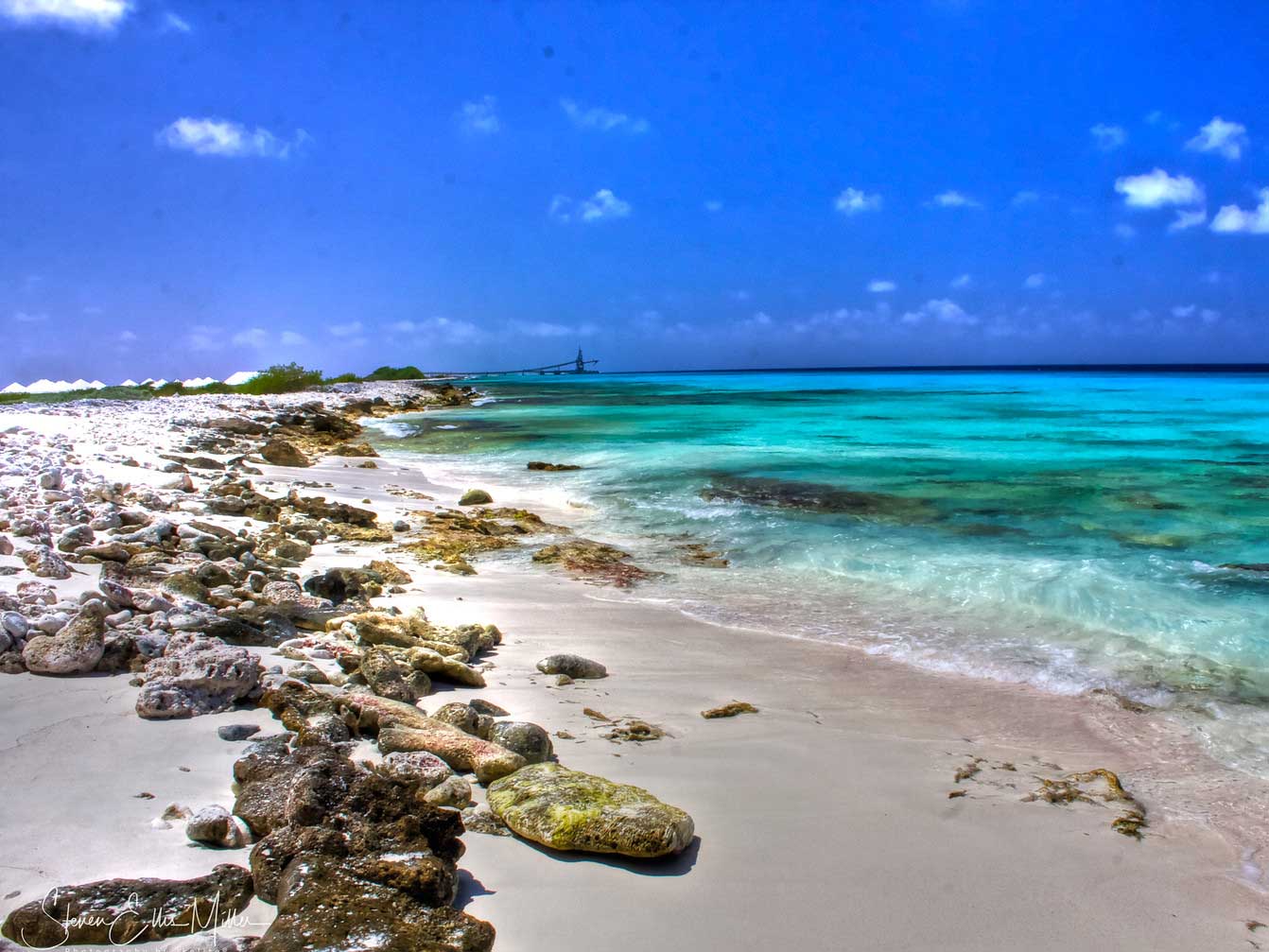By Steve Miller
Ambassador Steve Miller has worked as a representative of the Wakatobi Dive Resort for over 10 years and logged hundreds of dives on the surrounding reefs. Here are his top picks for must see diving in one of the most exclusive and pristine diving locations in the world.
There are so many different types of diving in the world, but for many of us the quintessential dive site is a sun drenched coral reef in crystal clear (and warm!) water, exploding with color and teeming with life.
When in pursuit of reefs with biodiversity that includes soft and hard corals as well as tropical fish you will inevitably end up in the Coral Triangle, a vast expanse of water and islands in the Pacific. It is known for species counts that would make the Caribbean green with envy. In one of the hearts of the Coral Triangle lies the archipelago of Wakatobi in Indonesian waters.
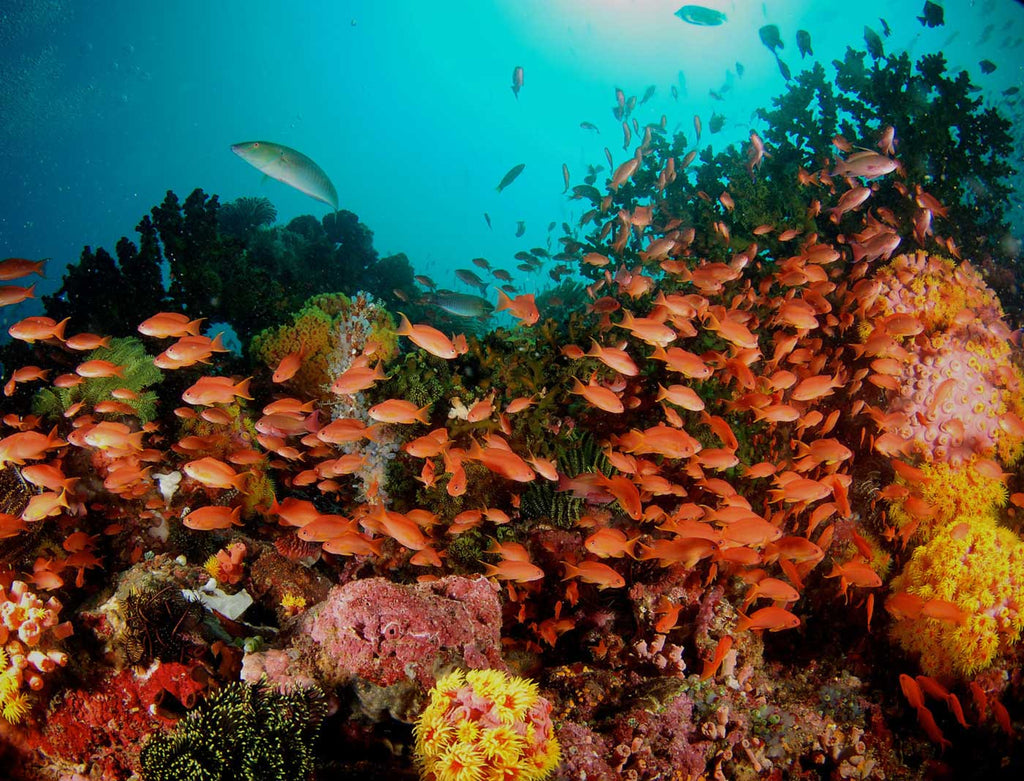
Teeming with life. Virtually every inch of bottom is covered in life, hard corals, soft corals, and billions of reef fish. Pro Tip: Most of us like to avoid shooting in a current, and with two tides per day the boats time to dive at slack tide. However, if you find yourself in a current (or plan a House Reef dive to use the current to return) you will notice something it took me years to realize... the reef loves current. Anthias come out, and are bold; soft corals plump up with water, and all of the tiny coral polyps come out to feed.
Getting there
A private air charter brings you from Bali to Wakatobi's purpose-built airstrip in a short, two-and-a-half hour flight. Then it's a quick shuttle by bus and boat to the resort. Once you meet Wakatobi staff in Bali you are 100% taken care of. The staff are trained to handle technical dive and photo gear and while you're on-island you hardly have to lift anything heavier than a fork if you don't want to.
The diving experience
Of no importance for anything but diving and snorkeling, Wakatobi is now one of the most well known dream diving destinations for divers who have (almost) seen it all. Photographers in particular will be torn between concentrating on the huge number of macro subjects that seem to be everywhere, or capturing that idyllic wide angle view with what seems like miles of visibility and a vibrancy of color that is unlike most diving experiences.
This is no accident. Wakatobi's location was specifically selected to be a diver's paradise for topography and biodiversity. Wakatobi is surrounded by one of the world's largest privately protected marine reserves which means that unlike most places, the diving just seems to get better and better each year.

Some of the flattest seas I have ever seen are at Wakatobi. When the ocean lays down like this, there is magic in the water. The sun rays behave differently, your lens can focus on clouds, and over/unders become much easier to shoot without a lot of wasted frames.
Having spent hundreds of hours on the reefs there, I hardly pay attention to the dive sites that are selected anymore; there simply are no bad ones. The dive sites are all different, but in a way all the same. Without exception the bottom will be covered in hard and soft corals, and the site will have shallows. This is partly because longer dives are a standard here (70 minutes or more) and multi-level diving is key to keeping safe from decompression sickness. So long periods of 30 minutes or so at the end of the dive are spent in 15-20 feet (5-7m) of water. This also means you can choose to do an entire dive quite shallow, whether it is for safety, or you just because you like the brightness and color that comes out in the shallows.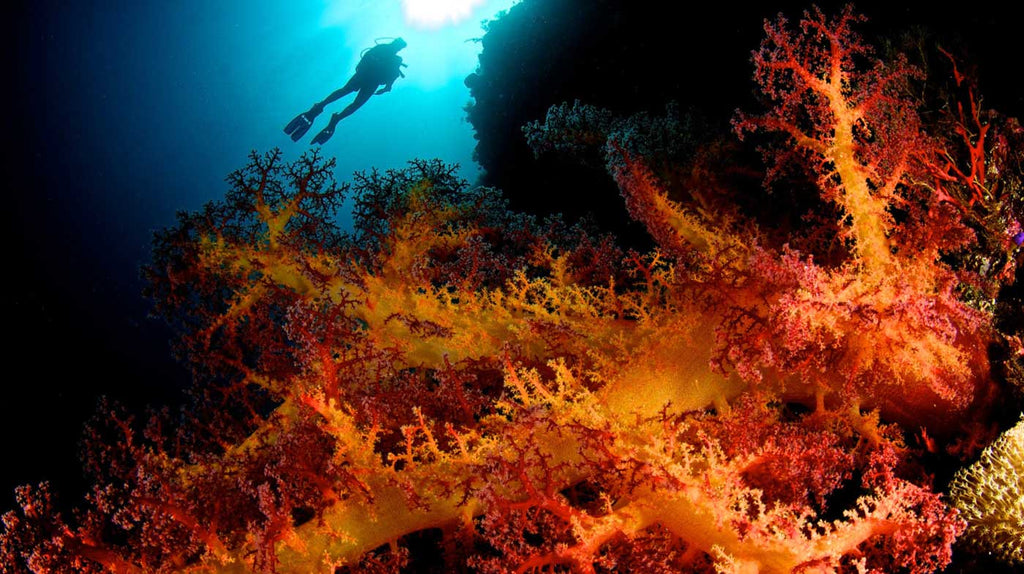
Giant soft corals in many different colors abound here. They will slump over when the water is still, but they inflate when there is a "breeze". Many places have these coral types here and there, or at specific sites. In Wakatobi they are everywhere, and at all depths.
If you’re a first time visitor then there are a few dive site names you may want to remember.
Blade
This site is called Blade because of it's shape. Wakatobi has hundreds of sites to pick within a very short ride from the resort, sometimes just 10-15 minutes. Blade is the furthest I have seen. The ride out to blade is about 45 minutes, making it a site that may be skipped in the event of windy conditions.
Blade is a pinnacle of sorts (or series of 3 pinnacles) and the name will make sense as soon as you hit the water. Most of us have dived walls before, and Wakatobi has plenty of them. Sometimes they are more vertical than others, but they always fall off to the right or left. Blade something different; it is like swimming along a knife edge that is about 20 feet (7m) across, and falls off on both sides. The sensation of seeing a wall to the right and left is unusual, and exciting. These pinnacles are also located at the intersection of major currents, so the life around them is exceptional even by Wakatobi standards.
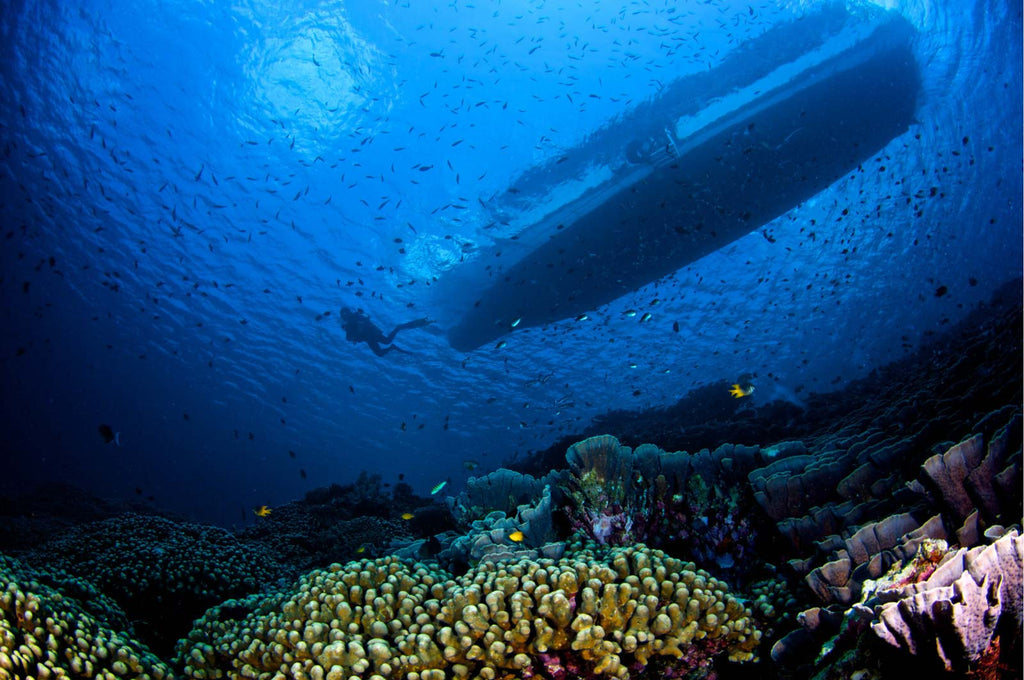
The potato coral in the foreground is a slice of a large field of that hard coral... very unique. The Zoo has large fields of hard corals of several varieties, and the reef fish use them for cover.
Zoo
Another name that's definitely worth mentioning is Zoo. A short ride from the resort, Zoo gets its name from the variety of animals residing there. This is also an example of a site being affected by intersecting currents. It begins in shallow flats and tumbles down a hill with the most elaborate hard coral structures you may ever see. The standard route will take you to around 75 feet (23m) max, but you can easily dive shallow on this site.
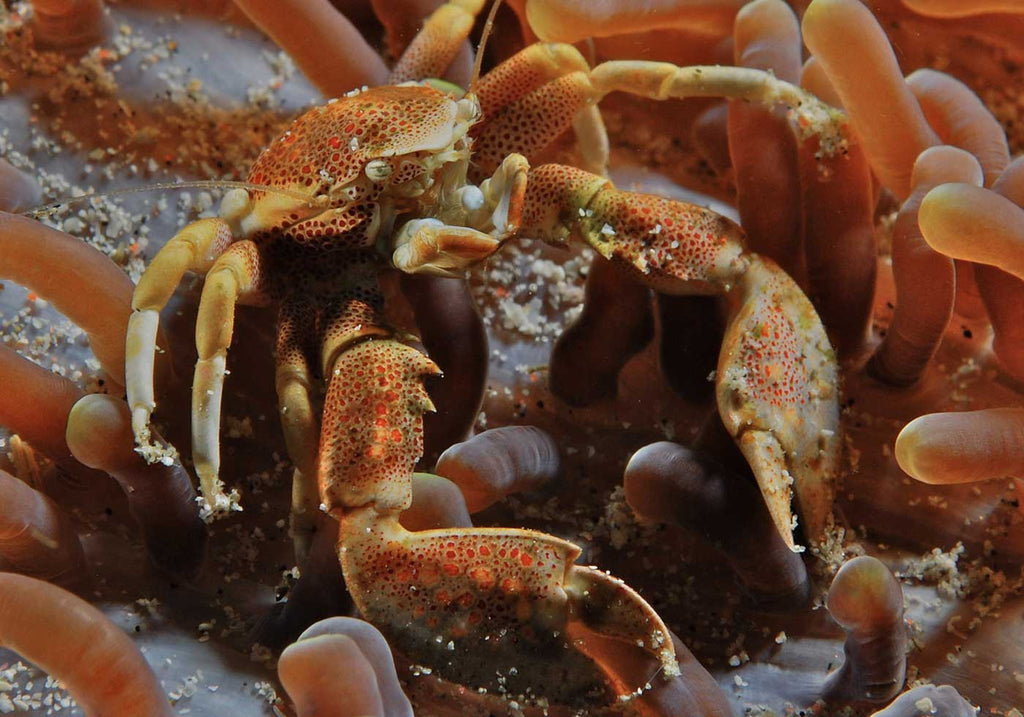
A porcelain crab sitting in an anemone. Anemones will sometimes live in the sand and get partially covered when the surge kicks up. They can reshape themselves and expel it later.
Teluk Maya
Teluk Maya means “beautiful bay,” and the site lies right around the corner from the resort. I mention this because it is the only site I know of where you drop down onto a sand bottom. There is very little sand bottom around Wakatobi except for the beach, because corals cover everything. Swimming along the sand bottom to patches of corals reveals bizarre animals to even the untrained eye.
Fluorescence (or "fluoro") can be seen by using a dichroic "excitation" filter on your strobe or light, and a yellow "barrier" filter on your mask and in front of your camera's lens. Many different types of corals and creatures fluoresce
Fluoro night diving
Fluorescence (fluoro) diving was pioneered at Wakatobi, among other locations. These dives are guided and private, largely for safety reasons. The lighting and filters needed makes anything fluorescing stand out like a neon light, but everything that isn't will be virtually invisible. This makes navigating the reef hazardous without a guide.
In Wakatobi, you will see fluoroscence as soon as you hit the water on any night dive. If you are looking for an alternative to pure fluoro that makes moving around easier and illuminates more of the reef, try adding luminance to your set-up. If you stick to deep reds, oranges, etc. on your lights then you can shoot fluoro but still see enough to move around at night. Try adhering colored gels to the fronts of a Gamma or any bright, handheld dive light.
The House Reef
There are many more sites like Fan 38 with its sheer vertical walls and Turkey Beach which is famous for lots of turtles (mis-translated as Turkeys once). But for me the best dive in Wakatobi is the House Reef.
This is taken under the jetty bar on the house reef. Depending on the relationship between the wind (surf size) and the tidal current coming in or out, this area can be crystal clear or murky. Ask any of the staff to help read the tide charts to catch this structure with visibility... usually just after the tide has switched.
The Jetty
It’s hard not to pause at the pilings supporting the end of the jetty, especially if you know what awaits. You are actually diving underneath the resort’s waterfront bar, with large concrete beams creating cover and shade. The entire area is simply packed with fish, large fish, so many that they will block the sun. There are also almost always a couple of sea snakes under the jetty, and for some reason, it can seem creepy to run into them in these dark, close quarters. Water clarity around the pier varies with the tide, and the usual 60-80 feet (18-24m) of visibility can seem cloudy compared to the nearby wall, where 100 foot (30m) plus vis is the norm.
The Drop Off
A quick peek under the jetty, and a few more yards of finning and you arrive at the drop-off. It is one of the most beautiful walls I have ever seen, rising from unseen depths to culminate in a reef top within five feet of the surface. Every square inch of this precipice is covered in life, and many sections are fully vertical, allowing you to get in close without worrying about errant fin contact.
Now, it’s decision time. You could go left, right, or neither. It’s possible to enjoy an entire dive without moving more than a few kicks from this spot. Hang near the reef top to discover several species of large anemones that perch on the edge, or you can dive deeper to discover a rich array of subjects hiding among the many crevices and overhangs below. The variety of nudibranchs, crabs, shrimp, and fish that are all within any given area of this reef are too numerous to list.

Sea anemones and their resident clownfish are a photographer's favorite. Here there are many distinctly different types, from huge purple balls, to deep dark red. Always with residents. The clownfish are the first you see, because they are flamboyant and perpetually moving, but closer inspection will often yield shrimp, crabs, and more photo opportunities per square foot than you'll have air for.
Conclusion
The resort cycles through dive sites so that you never see anyone else on a dive, and your boat will inevitably hit the most famous sites. Blade is the only exception, due to its distance from the resort.
As a photographer, I especially like the freedom that diving the House Reef allows. Even in small groups of four divers that is the standard ratio on the Wakatobi dive boats, it would be rude to linger too long at any given photo opportunity, so we often take a few shots, and move on. On the House Reef, there are no such limitations to your schedule. Choose one of the dive center’s large tanks, and with nearly 100 cubic feet of air at your disposal, you can stretch dive times to upwards of two hours without going into decompression.

This image is right off of the beach in front of the bungalows. Depending on the tide, you can shoot corals in just 1-2 feet (less than 1 meter) of water. Keep your eye on the tide, and the seas. If you see it lay down flat during low tide it's OK to get excited; I have even skipped a boat dive to snorkel the shallows right in front of the resort.
Rather than the usual “swim-and-shoot” dive plan, this freedom provides photographers with ample time to experiment and create that perfect image, the one worthy of the pages of a magazine. Conditions are perfect: bright sun and lots of it, 100 feet of visibility, and a pristine coral community to document. It’s like having your own underwater photo studio… which also happens to be one of the finest dive sites in the world.
The best part is that no matter what sites you visit during your stay, you will not leave wanting for more photo opportunities. You may want another week!
Want to chat about diving Wakatobi with an expert on the subject? Contact us!
Additional Reading
Steven Miller Ambassador Profile
How to Shoot Split Shots (Half-In, Half-Out of the Water)
Close Focus Wide Angle In Depth











